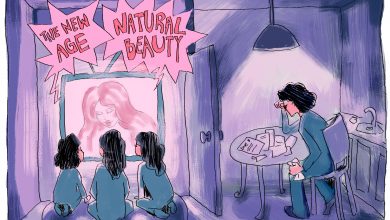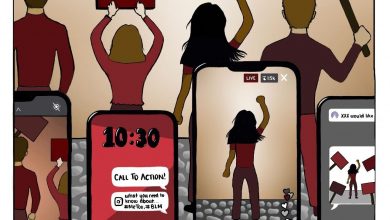Feminism 101: What is Heteronormativity?

Design by Magnolia Midori Casey
Heteronormativity is an ideology which states that heterosexuality is the normal, or natural, sexual orientation and aligns the gender binary, sexuality, and gender roles. Heteronormativity includes both the idea that there is only heterosexual orientation (cisgender female in relationship with cisgender male) and the idea of the gender binary (a rigid binary of only male or female). Heteronormativity confines us to strict gender roles that restrict how we think about sex and gender.
You want to know what heteronormativity is?
Heteronormativity is restrictive. Heteronormativity is dangerous. Heteronormativity is a poison.
In heteronormative society, people who identify contrary to what is considered ‘normal’ or ‘natural’ tend to have to explain or announce their sexual orientation or gender identity. This concept is not only backwards and creates hierarchical exclusivity, but also is harmful and invasive.
People should not have to explain why they are with their chosen partner or why they identify as a certain gender, and, on the flipside, they should not have to hide their sexual orientation or gender identity to keep themselves safe. Period.
Heteronormativity is often confused with homophobia since the appearance of the term hetero- implies that the topic solely focuses on sexuality, when it actually encompasses everything surrounding gender identity and sexuality. But, “homophobia is heteronormativity’s more outspoken, boisterous and occasionally aggressive cousin.” Homophobia is the fear or hatred of people who are gay, lesbian, or bisexual. Homophobic behavior is violent and dangerous to people whose sexual orientation is not heterosexual.
Heteronormativity has bred homophobia, transphobia, and other ignorant viewpoints. Heteronormativity affects all aspects of everyday life within policymaking, societal norms, gender roles, and the media we consume. Heteronormativity has created a stigmatizing and oppressive culture for individuals who do not conform to heteronormative expectations.
Within a heteronormative society, queer and trans people face punishment fo merely existing –– being queer or trans is punishable by death in many countries. A person who is queer and/or trans is highly vulnerable to murder.
Due to a heteronormative and non-inclusive society, there have been 22 Black trans women murdered in the U.S. this year alone. Those victims are just the ones that have been reported. This is just a small example of the violence against human beings that do not conform to heteronormative society.
Heteronormativity is a colonial concept. Prior to Britain and Spain’s colonization of various countries and Indigenous lands, there were (and continue to be) societies and cultures that embraced gender as a spectrum. “Sexual diversity has historically been the norm, not the exception, among Indigenous peoples.” In hundreds of different Indigenous cultures there is evidence of non-binary identity, non-monogamous relationships, and fluidity of sexuality. Heteronormativity was (and still is) shoved down people’s throats through lawmaking and societal discrimination.
Sex and gender discrimination comes from the roots of colonization which are capitalism, racism, and religious tyranny. Discrimination based on sex and gender is prevalent within the class system; there are more homeless LGBTQ+ youths in comparison to homeless heterosexual youths. To further put that into perspective, there are even significantly more homeless LGBTQ+ adults than homeless heterosexual youths.
Heteronormativity is ingrained in our society, consciously and subconsciously. There is the blatantly obvious lack of representation of people who do not identify within heteronormativity in media, i.e, movies, children’s stories, TV shows, etc. Then there are the less obvious subconscious heteronormative behaviors we unknowingly internalize based on assumptions created by gender roles. People often assume others’ sexualities based on how masculine or feminine they are. For example, heteronormativity tells us that women who identify as lesbian must be masculine. Heteronormativity has conditioned us to think men are masculine and women are feminine, and anyone who doesn’t fit the criteria is placed where society thinks makes sense.
Speaking of certain categories that society tries to confine everyone into, heteronormativity also enforces gender roles. Gender roles are the concepts of feminine and masculine qualities. These roles represent social expectations that define the heteronormative ideas of cisgender men and women. They are learned behaviors people take on in order to fit into the dominant cultural norms. Although present-day communities are often more accepting of diverse sexualities and genders than they were a mere ten years ago, there is still stigma surrounding people who do not conform to gender roles. Unless these backwards concepts are abolished, the fight for sexual orientation and gender equality is far from over.
Gender roles are cultural.
Lack of representation of diverse sexualities and gender identities leads to heteronormativity being a societal default, since there is no accurate representation to teach and inform people about the many sexual orientations and gender identities.
This is especially dangerous for children, since it further ingrains heteronormativity into the minds of the next generation. Children consume what they see and mimic and behave the way they are taught.
Gay and trans representation in media will not “turn a child gay.” That is LITERALLY not how it works. If a child does identitfy as gay, trans, or another identity, in a heteronormative society, it is detrimental to their mental and emotional health since the media they consume, and the way they are brought up, is constantly pushing an identity they are not.
A heteronormative society is the reason the LGBTQ+ community suffers more in their mental health than straight, cisgender people. According to GQ magazine, through conducting a survey of their readers, “45% of gay, bi, and trans men have, in the last year, thought life was not worth living, while 34% have considered taking their own lives in that same period, with 5% actually attempting it.” The violence does not end there— LGBTQ+ youth are twice as likely to be physically assaulted. There is a constant pressure to fit into a certain category and restriction of basic human rights from those who do not.
Within the LGBTQ+ community, gay men and women often face ignorant ideas that in order to be a gay person you have to identify with the gender roles that society ascribes to the ‘opposite’ gender. For example, people often think that lesbians are only hairy, angry, hypermasculine d*kes and have no proper placement in society. Lesbians are, then, not considered women but also not considered men. For instance, cisgender, straight people are often shocked to discover that their coworkers are gay because they do not “seem” or “act” gay.
Heteronormative society ingrains the prejudice or dislike of people who are ‘different.’ Due to gender roles within heteronormativity, it is ‘natural’ to assume that if someone does not fit in one category, they must be either the opposite or a weird outlier.
Another component of gender roles is the restriction and shame of sex. This includes the sexist ideas of a woman’s virginity, double standards when it comes to pleasure and enjoyment, and kink-shaming. A woman’s virginity comes from religious and patriarchal ideas that a woman is a commodity and her purity is all that she is worth. It is a damn social construct. A man’s pleasure is prioritized over the comfort, and possibly pain, of a woman during sex. Under gender roles, it is a woman’s job to pleasure a man and make sure he ejaculates. This dangerous viewpoint can cause physical and emotional harm to women because oftentimes men do not know if they are being harmful because within heteronormativity they do not focus on how the woman feels. This contrasts with the realities of disappointing sex and fears of telling your partner what you actually enjoy during sex. Sex is treated like something that brings men power, but for women, sex is something to be ashamed of. Men are given far more sexual freedom in society; a high body count is a reward.
Gender roles make us think about sex from the perspective of straight, cisgender men. For instance, men are told that they need to be some sort of dominating masculine presence in all aspects of life, especially around women. Men and women are treated with a power differential that amplifies men’s sexual dominance and eradicates women’s pleasure. The internet is full of jokes about the inability of men to find the clitoris or how straight cisgender women do not enjoy sex and use it to get something out of their husbands, boyfriends, etc.
The way sex is taught is shamefully biased. In grade school, I recall only the discussion of male ejaculation and male protection. Although the course is Sex Ed and is oriented around pregnancy and child development, even as children, we are taught that sex starts and ends with male participation. Sexual power for men stems from heteronormativity enforcing patriarchal norms. From a young age, the act of sex is focused on male ejaculation in order to conceive. As children grow up and start becoming sexually active, boys are encouraged to masturbate and tend to their arousal while most girls have no idea that masturbation for us exists. Men are given the power to own their sexuality and bask in it, while women are not encouraged to explore or even taught about their own sensualities.
The focalization of men’s perspective on sex can help us further understand the never-ending history of viewing women as less than. Our sensuality and sexual dynamics are snuffed out under the foot of patriarchal heteronormativity, because if a man cannot have power in every aspect of everyone’s damn life then how does he have value in a heteronormative role?
You may be asking yourself, how are we supposed to help? How do we fix a system that has built such an indestructible foundation?
For starters, it is not indestructible.
Many societies have lived with respect to the spectrum of sexuality and gender. Like I mentioned earlier, there were, and are, Indigenous people who believe in freedom of sexuality and gender. It is possible to live in a world free from heteronormativity. One that does not capitalize off of sexual and gender discrimination.
The hardest part of making a change is starting. Start within and show by example. Putting your gender pronouns on social media in order to normalize it for trans and nonbinary people. Support diversity, be an advocate, support when no one is watching. Go to parades, rallies, call out bigotry. Support foundations and fundraisers for LGBTQ+ youth. Teach those around you. There are hundreds of organizations that support the LGBTQ+ community. The Trans Women of Color Solidarity Network and/or the United Territories of Pacific Islanders Alliance are some organizations that support trans women of color. These communities provide a safe and supportive space as well as advocating for social justice. If we do not show up for each other, who will show up when everyone is silenced? Once we are able to undo the brainwashing of heteronormativity and spread awareness, heteronormative culture loses any foothold it has in our lives.




